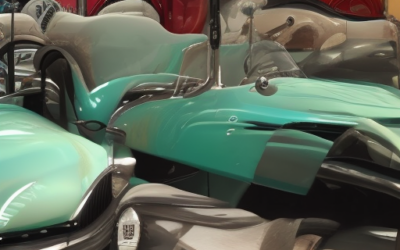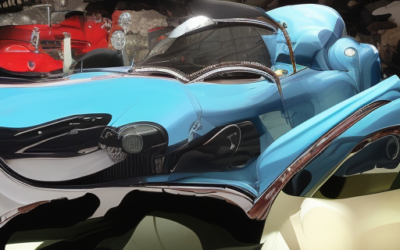Winter Antique Car Care: Tips for Protecting Your Classic Ride
1. Preparing Your Classic Ride for Winter
Winter is coming, and it’s time to prepare your classic ride for the cold weather ahead. Here are some tips to keep your car in top condition during the winter months.
First, make sure your battery is in good shape. Cold temperatures can cause a battery to drain faster, so it’s important to check the voltage and clean the terminals if necessary. You may also want to invest in a battery tender to keep the battery charged while your car is parked.
Next, check the tire pressure and make sure they are properly inflated. Cold temperatures can cause the air in your tires to contract, which can lead to a flat or a blowout. Check the tread depth as well, and replace any worn-out or damaged tires.
It’s also a good idea to change the oil and filter before the winter season starts. This will help prevent engine damage from the cold temperatures and the increased demand for fuel. Additionally, consider adding a bottle of antifreeze to your radiator to protect against freezing.
Finally, make sure your wipers are in good condition and have enough fluid. Cold weather can cause the rubber to become stiff and crack, which can lead to poor visibility when driving. Replace any worn-out wipers and make sure there is enough fluid in the reservoir.
2. Storing Your Car Properly
To ensure that your classic car remains in top condition during the winter months, it’s important to store it properly. Here are some tips for storing your car correctly:
1. Choose a Dry and Cool Location: Look for a garage or shed that is dry and cool, away from direct sunlight and moisture. This will help prevent rust and corrosion from forming on your car.
2. Use a High-Quality Cover: A good quality cover will protect your car from dust, dirt, and debris, as well as provide additional insulation to keep the temperature inside the garage consistent.
3. Check the Battery: Before storing your car, check the battery to make sure it’s fully charged. If necessary, have it serviced or replaced to avoid any issues when you’re ready to drive again.
4. Turn Off the Engine: Make sure to turn off the engine and remove the key before storing your car. This will help prevent any damage to the starter motor or ignition system.
5. Take Out the Gas: Remove all fuel from the tank to prevent any water from entering and causing corrosion. It’s also a good idea to add a stabilizer to the gas to help preserve it.
6. Apply Wax or Sealant: To protect the paint job, apply a wax or sealant to the exterior of your car. This will help repel moisture and prevent scratches from occurring.
7. Disconnect Battery Terminals: To further protect your car from potential electrical issues, disconnect the battery terminals using a specialized tool. This will prevent any unwanted connections or sparks from causing damage.
3. Keeping the Engine Running Smoothly
Winter can be tough on classic cars, especially when it comes to the engine. To keep your car running smoothly during the winter months, here are some tips to follow:
1. Change the oil and filter before the cold weather sets in. This will ensure that your engine has enough lubrication to prevent wear and tear.
2. Check the coolant levels and top them off if necessary. Cold temperatures can cause the coolant to expand, so it’s important to have enough to avoid overheating.
3. Make sure the fuel lines and hoses are in good condition and not prone to freezing or cracking. If you notice any damage, have them repaired or replaced before the weather gets too cold.
4. Check the battery and make sure it’s fully charged. Cold temperatures can cause the battery to drain faster, so it’s important to keep it well-charged.
5. Use a winterization kit to protect your fuel system from gelling. This will prevent your car from being stranded due to frozen fuel.
By following these simple tips, you can help keep your classic car’s engine running smoothly during the winter months. Remember to also check your car regularly throughout the season to ensure everything is still in good working order.
4. Maintaining the Exterior
Winter can be tough on classic cars, so it’s important to take extra care of the exterior to keep your ride looking its best. Here are some tips for maintaining the exterior of your antique car during the winter months:
1. Wash and wax your car regularly: Just like your skin, your car’s paint job needs attention to stay healthy. Make sure to wash and wax your car at least once a month to remove dirt and debris and protect the paint from the elements.
2. Apply a protective coat: In addition to washing and waxing, apply a protective coat to your car’s exterior to create an additional layer of protection against the harsh winter weather. This can include products such as wax, sealant, or a ceramic coating.
3. Cover your car when not in use: If you won’t be using your car for an extended period of time, cover it with a blanket or car cover to protect it from snow, ice, and other debris.
4. Check for rust and damage: Regularly inspect your car’s exterior for any signs of rust or damage, and address any issues promptly to prevent them from getting worse.
5. Use a dedicated antifreeze solution: To protect your car’s engine from freezing, use a dedicated antifreeze solution that is specifically designed for classic cars. This will help to keep your car running smoothly even in subzero temperatures.
5. Protecting the Interior
Winter can be tough on classic car interiors. The cold temperatures can cause cracking and splitting in leather seats, while the dry air can lead to brittle plastics and broken dashboard components. To protect your classic ride’s interior during the winter months, follow these tips:
1. Use a car cover: A high-quality car cover will keep your car’s interior protected from the elements. Look for a cover that is specifically designed for antique cars, as it will fit snugly over the curves and contours of your vehicle.
2. Apply a protective coating: There are many products available that can be applied to leather seats to help protect them from the effects of winter weather. These coatings can help prevent cracking and splitting, and they can also repel stains and spills.
3. Use a humidifier: Dry air can wreak havoc on classic car interiors, so consider using a humidifier to add moisture to the air. This can help prevent brittle plastics and broken dashboard components.
4. Keep the windows closed: When the temperature drops below freezing, it’s important to keep the windows closed to prevent moisture from forming inside the car. This can lead to rust and corrosion, which can damage your classic ride’s interior.
5. Consider using a heater: If you plan on driving your classic car during the winter months, consider using a heater to warm up the interior before you get in. This can help prevent cracking and splitting in leather seats, and it can also make the car more comfortable to drive.
6. Preserving the Wheels and Tires
Winter weather can take a toll on your antique car’s wheels and tires. To ensure they remain in good condition, it’s essential to take proper care of them during the winter months. Here are some tips for preserving your car’s wheels and tires:
1. Check the Pressure Regularly: Make sure to check the pressure in all four tires at least once a month. This will help prevent flat tires and ensure your car handles properly.
2. Use a Tire Inflator: If you notice any drop in tire pressure, use a tire inflator to add air. Be careful not to overinflate the tires, as this can cause damage to the sidewalls.
3. Rotate the Tires: It’s important to rotate the tires regularly to ensure even wear. This should be done every 6,000 to 8,000 miles.
4. Inspect the Tires Visually: Look for any signs of wear, such as bald spots or cracks. If you see any issues, replace the tires immediately.
5. Store the Tires Properly: When storing your car for the winter, make sure to store the tires in a warm, dry place. This will help prevent cracking and other forms of damage.
By following these simple steps, you can help preserve your antique car’s wheels and tires throughout the winter months. Remember to always prioritize safety when driving in cold weather conditions.
7. Caring for the Brakes
Caring for your brakes during the winter months is essential to ensure safe operation of your antique car. Here are some tips to keep your brakes in top condition:
* Check the brake fluid level regularly and top off as needed.
* Clean the brake dust and debris from the calipers and rotors using a degreaser and soft cloth.
* Inspect the brake pads and shoes for wear and replace them if necessary.
* Lubricate the brake pivot points and wheel bearings with a high-temperature grease.
* Test the brakes by gently applying pressure to the brake pedal. If there is any squeaking or grinding noise, have the brakes inspected by a professional.
8. Ensuring Proper Ventilation
Proper ventilation is crucial during the winter months to prevent moisture buildup in your classic car. Moisture can cause rust and corrosion, which can damage your vehicle’s exterior and interior. Here are some tips for ensuring proper ventilation:
* Check the weatherstripping around doors and windows to make sure it is sealed properly. This will prevent cold air from entering the car and causing moisture buildup.
* Use a dehumidifier to remove excess moisture from the air inside the car. This will help prevent mold and mildew growth, which can damage your upholstery and carpets.
* Make sure the exhaust system is functioning properly. A clogged or damaged exhaust system can cause carbon monoxide to build up inside the car, which can be dangerous for you and your passengers.
* Consider using a car cover to protect your car from moisture when it’s not in use. A cover can also help keep your car clean and free of debris.
9. Dealing with Ice and Snow
Winter brings with it a unique set of challenges for classic car owners. One of the biggest concerns is dealing with ice and snow. Here are some tips for keeping your classic ride safe during the winter months:
1. Make sure your wipers are in good working order. Blurry vision while driving can be dangerous, especially on slippery roads.
2. Check your windshield wiper blades regularly to ensure they are not worn out or damaged. Replace them if necessary.
3. Use a winter wash and wax to protect your paint job from the elements. This will also help prevent rust and corrosion.
4. Install winter tires with better traction on snowy and icy roads. All-season tires may not provide enough grip in cold weather conditions.
5. Keep a winter survival kit in your car. This should include items such as blankets, a flashlight, a first aid kit, and a cell phone charger.
6. Be prepared for emergency situations by having a plan in place. This could include knowing the location of nearby garages or emergency services.
10. Planning for Emergencies
It’s important to plan ahead for emergencies during the winter months. This includes having a winter survival kit in your car, which should include items such as blankets, a flashlight, a first aid kit, and a cell phone charger. It’s also a good idea to have a spare key for your car in a safe place, in case you lose your keys or they become stuck in the ignition. Additionally, it’s important to know the location of the nearest emergency service providers and to have a plan for getting your classic ride towed if it breaks down. By taking these precautions, you can help ensure that you and your classic ride are prepared for any unexpected situations that may arise during the winter season.














0 Comments